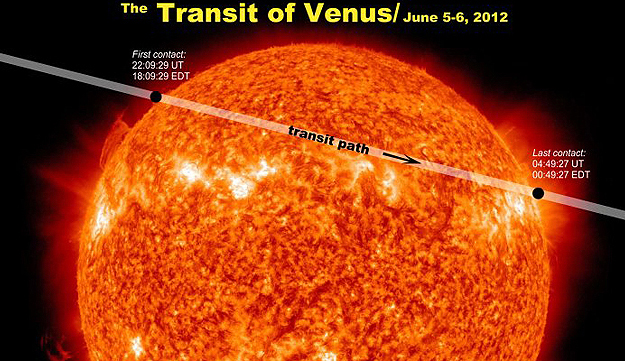Live Webcast of Transit of Venus, June 5

On June 5, 2012, the Exploratorium presents a live webcast for the viewing of the transit of Venus, an astronomical phenomenon that will not occur again until the years 2117 and 2125.
An Exploratorium crew is webcasting this special 6.5-hour event live from the Mauna Loa Observatory on the big island of Hawaii. A telescope feed will be accompanied by audio commentary every 30 minutes. Visitors to the Exploratorium can view the phenomenon on large screens during museum hours, and others worldwide can watch it via the Internet at http://www.exploratorium.edu/venus
Proper safety eye wear (eclipse glasses or #14 welders’ glasses) are required to view the transit directly; learn how to make your own solar viewer at http://youtu.be/r6hj3rxG_EQ
In addition to making this program available on the Internet, the feed is also shared with a variety of other museums and planetariums, including the Royal Observatory in Greenwich, the Rose Center for Earth and Space at the American Museum of Natural History, the Sydney Observatory, the New York Science Festival, and the California Academy of Science.

When the Earth, Venus, and the Sun line up, we can see Venus transit or travel across the face of the Sun like a speck. These rare alignments are scientifically important because they allowed researchers to determine a close estimate of the distance from the Earth to the Sun, about 93 million miles. This distance is also known as an astronomical unit (AU). In turn, scientists used this information to calculate the dimensions of the entire solar system.
These transits occur in pairs that are eight years apart and then don’t happen again for more than a hundred years. This will be the last chance in this century to witness a transit of Venus — but people in many parts of the world, including North America, Europe, Asia, and eastern Africa, will be able to see at least part of the transit in person. The 2012 transit follows the transit of 2004. The last two previous Venus transits were in 1874 and 1882.
Some Local Dates and Times for the Webcast
San Francisco: June 5, 3:09 p.m. to 9:49 p.m. PDT
Mauna Loa Observatory: June 5, 12:09 p.m. to 6:49 p.m. HADT
New York: June 5, 6:09 p.m. to June 6, 12:49 a.m. EDT
Greenwich: June 5, 11:09 p.m. to June 6, 5:49 a.m. BST
Sydney: June 6, 8:09 a.m. to 2:49 p.m. EST
Contacts:
Linda Dackman
+1 415. 561. 0363
pubinfo@exploratorium.edu
Leslie Patterson
+1 415. 561.0377
images@exploratorium.edu
The Mauna Loa Observatory is a National Oceanic and Atmospheric Administration (NOAA) facility. NOAA is engaged in a five-year educational partnership with the Exploratorium to bring environmental science and Earth observation capabilities to the museum’s future location at San Francisco’s Pier 15. As part of its long-term science mission, NOAA tracks atmospheric carbon dioxide and other greenhouse gases from five baseline observatories, including one near the top of Hawaii’s big island volcano.
The Exploratorium is located inside the Palace of Fine Arts in San Francisco’s Marina District. The Exploratorium plans to relocate to its new home on the waterfront in Pier 15 in Spring 2013. It will remain open in its current home through early January 2013.









